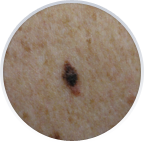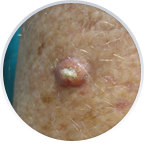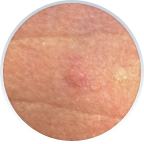Melanoma Is Not The Only Life Threatening Skin Cancer
MoleMedic has expertise and experience in diagnosing skin cancers
No referral is necessary before booking an appointment
Melanoma and other skin cancers

Melanoma
This mole, excised at MoleMedic, was reported by the histopathologist as a melanoma in situ.
Melanoma in situ is the very earliest stage of melanoma. Removal at this stage offers the best outcome.

Squamous Cell Carcinoma (SCC)
Squamous Cell Carcinomas mostly occur in sun affected skin. The appearance of SCCs can be quite variable – not all SCCs are as obvious as this

Basal Cell Carcinoma (BCC)
This is an example of a very early stage BCC.
A BCC is the most common form of skin cancer and is a locally invasive, keratinocyte cancer
Skin cancers picked up by MoleMedic (shown with patient consent)
Find out more about different skin cancers
Warning signs of skin cancers
Skin Cancer Symptoms
If you notice …
…Any skin sore which does not heal, repeatedly bleeds, or looks like an ulcer
…Any new enlarging mole
…Any existing mole that changes in size, changes in colour, or has an irregular border
…Any mole that becomes irritated
…. book a check up at MoleMedic
Melanoma
Melanoma is a skin cancer which can be aggressive and deadly. If it is not diagnosed until an advanced stage it can metastasize (spread to other organs) quickly and cure is much less likely.
If detected at an early stage a malignant melanoma can be fully excised and any spread prevented. All malignant melanomas need to be removed as soon as suspected or detected.
Melanoma may start as an innocent looking mole, and small changes or irritation may be the indication that it needs to be checked.
Melanoma is usually a brown (pigmented) mole, but it can also be pink, so any new or changing skin spot needs to be checked.
What is metastatic melanoma?
Metastatic Melanoma, also known as Stage IV melanoma, is the general term for the spreading of melanoma into the lymph nodes and/or other parts of the body.
As detailed by the Melanoma Research Foundation, the most dangerous aspect of melanoma is its ability, in later stages, to spread (metastasize) to other organs of the body.
Most often the liver, lungs and brain become affected. Even though the cancer cells have spread to other organs, this cancer is still melanoma.
Basal cell carcinomas (BCCs)
Basal cell carcinoma is the most common skin cancer.
Fair–skinned people who have had a lot of sun exposure are particularly vulnerable.
BCCs are more common as we get older, and tend to occur in the areas which have had the most sun. They may also appear in young people in their 20s and 30s.
A basal cell carcinoma will often be apparent as a sore that doesn’t heal or a new raised skin spot. They do not metastasize, but they do grow. They can infiltrate and cause local damage especially on the head and neck
They can be treated in the early superficial stages with freezing (cryotherapy) or creams such as Efudix or Aldara.
Most BCCs need to be removed surgically.
Squamous cell carcinomas (SCCs)
Squamous cell carcinoma is another non- pigmented skin cancer which at times is just a local skin spot or raised nodule needing removal.
Some SCCs especially those on the head and neck can metastasize (spread to other organs in the body).
SCCs are also more common in the exposed parts of our bodies, and more common as we get older.
Like BCCs they can be quite small and superficial and cured by removal.
Interesting Information from Outside Sources
Sometimes we read an article or see something online that we think adds value to an understanding about skin cancers and melanoma. We are happy to share it with our patients. The links are below
Why you might want to believe there’s no such thing as a safe tan as explained by Prof H. Peter Soyer – Professor of Dermatology, The University of Queensland – in this article published by The Conversation, Jan 11 2019.
This article from The Conversation published on 8 January 2018 helps to explain what the SPF factor means. There is wide confusion about whether it means you can spend a longer time in the sun, or whether it “covers up” more. “How does sunscreen work, what is SPF and can I still tan with it on?”
This is a link to a good article published in the New Zealand Herald on 3 September 2017.
The article is titled “These are the signs to watch for when checking for skin cancer”
